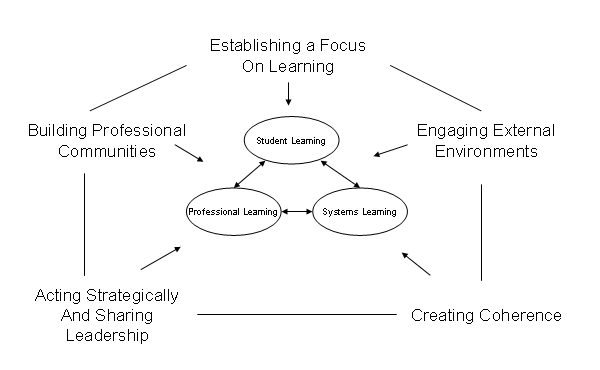





LEADING TO LEARN
I am sumarizing the Center for the Study of Teaching and Policy Leading for Learning framework and its related Sourcebook to assess what Alameda can do to accomplish "Student Success -Whatever It Takes" in the AUSD Strategic Plan for 2003-2008.
To establish a focus on learning, the definition of “learning” needs to be established for the three domains.
Student Learning
Students’ opportunities for learning reside in the interactions among students, teachers and content. Their learning – the outcome of those interactions- depends on how teachers implement curriculum, design academic tasks and engage students in these tasks, as well as how students approach their teachers, each other and their work.
In 2007, AUSD embarked on a coordinated effort of professional development through the rollout of the Strategic Instruction Model (SIM) that is focused on Student Learning.
Professional Learning
Teachers’ learning includes the knowledge, skills and perspectives they acquire while preparing for and renewing their practice. Opportunities for effective professional development include those that come interacting with other professionals who offer ideas, critique, inspiration and moral support in the renewal process.System Learning
Through inquiry into how a district performs, leaders can support “system learning”. Opportunities for system learning arise through strategic planning endeavors, evaluation of policies, programs and resources use; and monitoring of indicators to measure progress toward defined goals.
All three learning domains in contextAll three learning domains act as context for the other two. At the same time, all three learning domains are influenced by larger domains. The District, families and the community, and the State and Federal domain all enable and constrain the learning of everyone in the system.

Strategic Plan Review
Alameda Unified has defined the strategic focus of the 2003-2008 plan as the student’s ability to pass District and State assessment tests. Within the context of student learning, what additional indicators can be used to broaden Alameda’s definition of student success?
Looking at the Graduate Profile Outcomes, there appears to be some areas where indicators could be developed. The Graduate Profile Outcomes are:
Looking at the Vision statement, additional areas from the We Are Most Proud That section could be:
Additional Resources
Here are five dimensions that the The Center for Language in Learning have identified for student learning.
Back to Leading to Learn Summary
Send mail to mikemcmahonausd@yahoo.com with
questions or comments about this web site.
Last modified: July 2, 2003
Disclaimer: This website is the sole responsibility of Mike McMahon. It does not represent any official opinions, statement of facts or positions of the Alameda Unified School District. Its sole purpose is to disseminate information to interested individuals in the Alameda community.